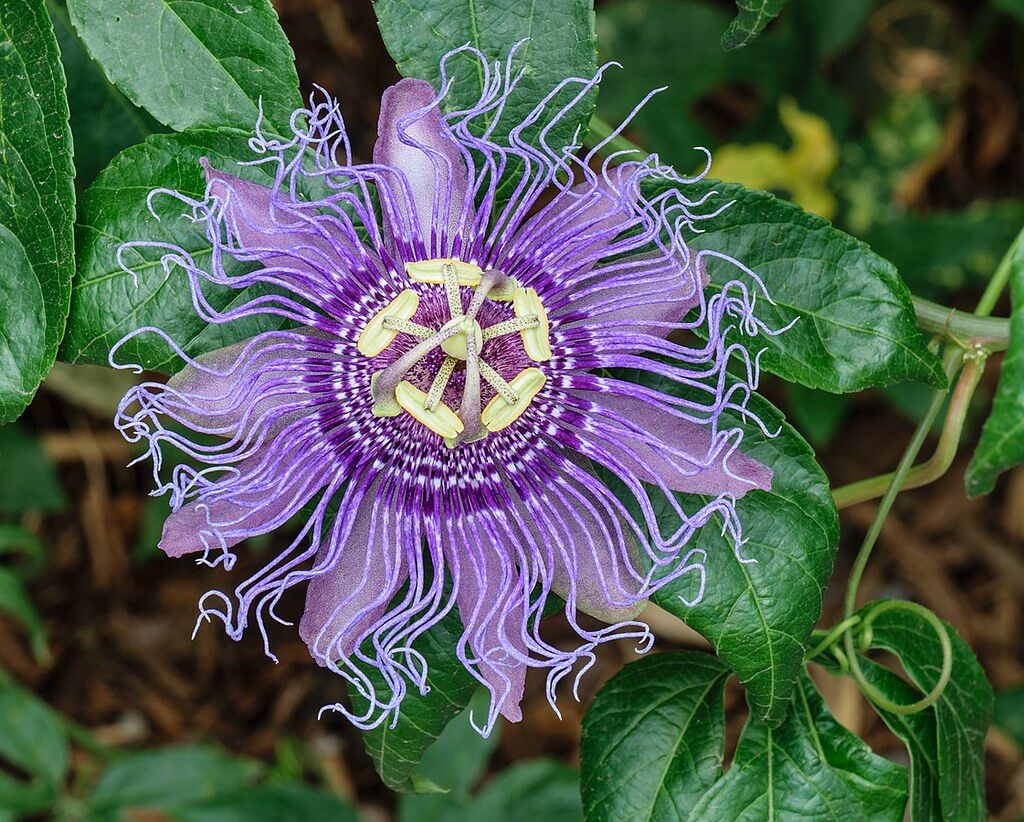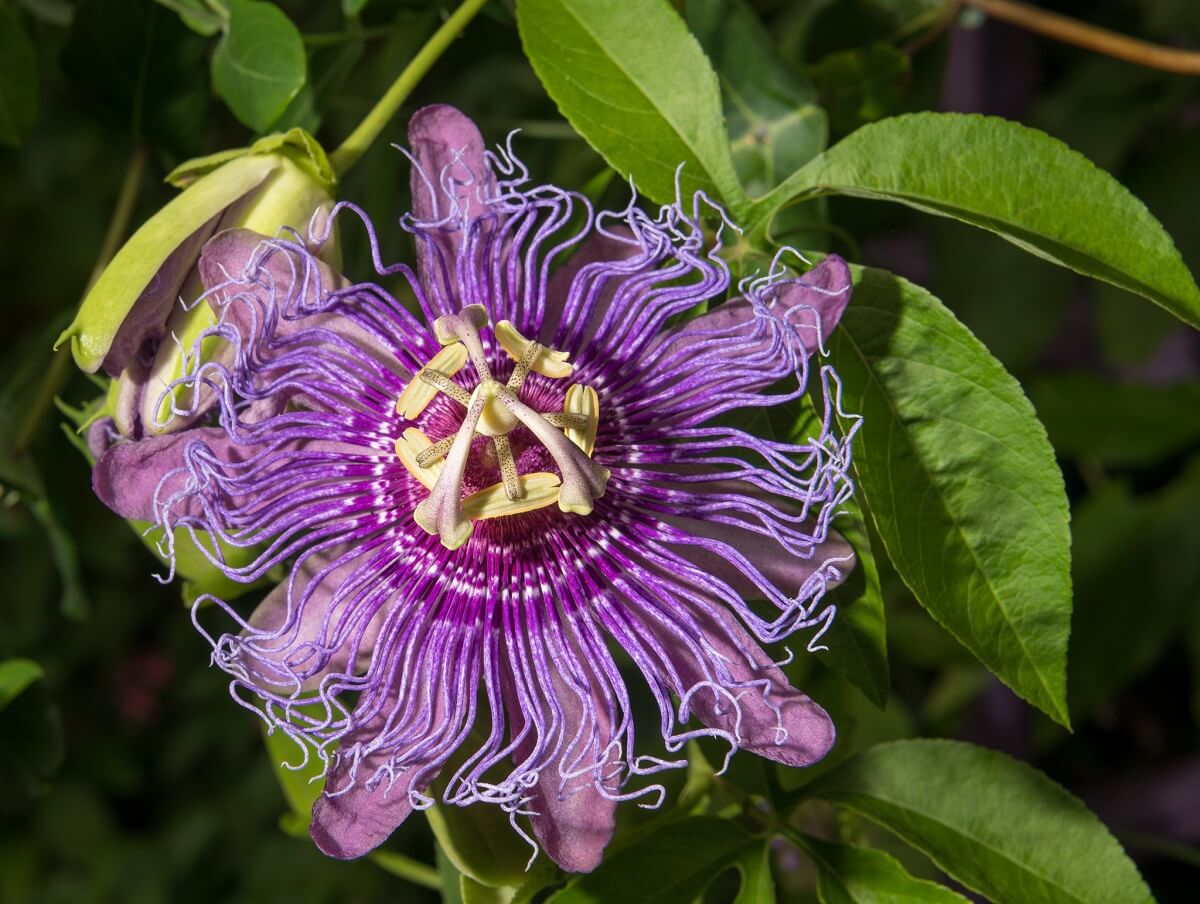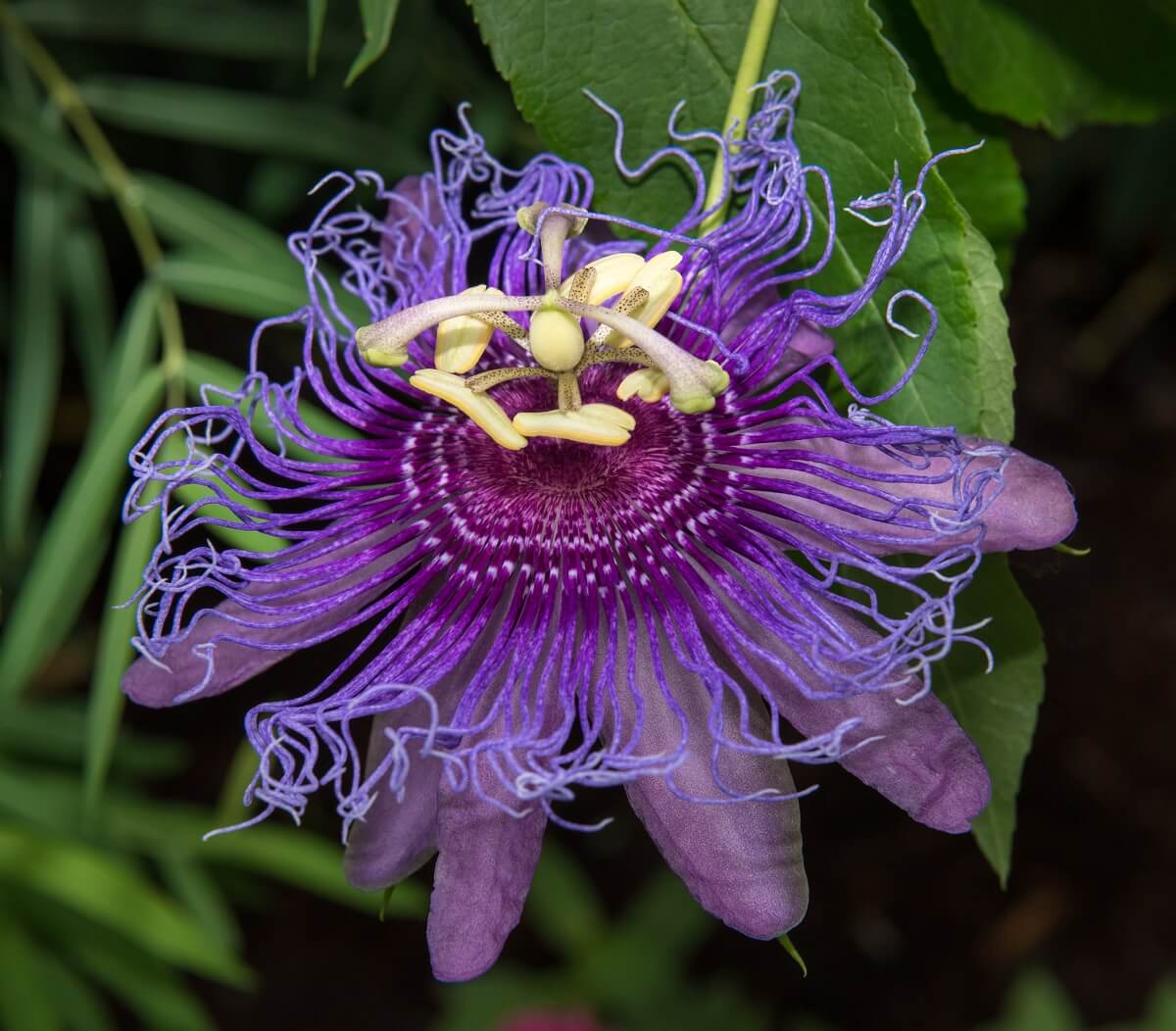“Did you know there are hundreds of varieties of passionflowers?”
I thought I was talking to my husband, but he had wandered off to another part of the nursery while I studied the array of color in front of me. Glancing around, I realized I’d been talking to myself with others giving me wary looks. What can I say? I’m just another passionate gardener who talks to flowers.
I had to smile. Why not enjoy the moment? And the colors in the display of Passionflowers. I had never grown them before, but I was always game to try something new, and the purple passionflowers that dominated the trays were delightful.

I had come to the nursery with the purpose of finding this flower. I didn’t need anything else for my garden. After reading about the purple passionflower (Passiflora incarnata) and listening to one of my gardening friends rave about the beautiful, purple flower — not to mention the medicinal benefits this plant offered — I knew it was a must-have for my garden. And, despite my husband’s attempts to dissuade me, I had a spot picked out, and the plot was ready for my purple passionflower garden.
Related Post: Homestead Stories: A Colorful Zinnia Extravaganza
I have to admit, part of the attraction to this flower was the name. I always assumed its name, ‘passion’ flower, had a romantic attachment. Indeed, I felt passionate about the plant. But my research revealed otherwise. The name passionflower had its roots in Christianity and the Passion of Christ.
Missionaries gave it the name passionflower because it had three stamens in the flower which they associated with the three wounds of Christ, and its 12 petals represented the 12 apostles. They also viewed the plant’s corona as being symbolic of Christ’s crown of thorns. I found the background interesting, though I still had a personal sentiment of passion for the flower.

I finally found the purple passionflower tucked in the back corner of the nursery. There was only one.
“It’ll take over your garden,” a woman’s voice came from behind. I turned to see one of the nursery attendants watering nearby. She must have seen me studying the plant with interest.
Related Post: How To Care For Orchids
I smiled at her. “I know. I hope it does. At least, in the garden where I intend to plant it.”
“It’s really a vine,” she added. “It’ll grow to about 20 feet. I hope you have something it can climb like you would with a clematis.”
“I do.” I hoped my rock wall would suffice, but I was beginning to wonder.
“It is a beautiful flower,” the woman agreed. “And it has many uses other than ornamental.”
“Really?” I was surprised. I’d have to do more research after I got it home and planted. I picked up the pot and walked purposefully towards the cash register. My husband appeared as I was about to pay. He was shaking his head but knew better than to comment.
“Whatever you do in the garden is wonderful,” he muttered (the words he often used when giving in to my ideas). We had a piece of country paradise; a perfect location to expand our dream gardens. And that’s what I was doing, one plant at a time.
My purple passionflower did grow fast and tall. The 3-inch wide flowers — some of which were accented with a purple fringe — had a wonderful fragrance that reminded me of carnations.

The fruit, when it appeared, was elongated, about 2 to 8 inches long and 2 inches across. It looked something like a yellow plum, and I quickly learned that although the fruit was edible, it tasted best when allowed to fall from the vine. Then, it tasted like guava. Well, sort of.
The leaves were really large at 5 to 6 inches long with serrated edges. They provided a rich green canopy for the flower blooms that appeared where the leaf stem attached to the vine. I quickly learned that my rock wall wasn’t sufficient, and my husband was enlisted to construct a sturdy trellis.
Related Post: Bee Balms Or Bee Bums?
Butterflies and bees flocked to my passionflower, enjoying the flower’s sweet nectar. Unfortunately, so did the caterpillars and aphids. I rigorously sprayed the vines with insecticidal soap at first sight of the invading, destructive insects.
My passionflower thrived in the place I had chosen for it. The soil was a fertile mixture with a base of sand giving it sufficient drainage. There was lots of direct sunlight, and I made sure the plant was well watered.
In addition to the fruit, there are other edible and medicinal benefits to the passionflower plant. The best time to harvest, of course, is in the fall. Strip the leaves off the plant and allow them to dry thoroughly as you would with herbs. You can even eat the aril which is the gelatinous covering of the seed.
Related Post: Edible Flowers
The medicinal benefits of passionflower haven’t been fully researched and explored. Until the late 1970s, passionflower was a component of over-the-counter sleep drugs. In fact, it has been proven to be beneficial in treating insomnia. It is also believed to benefit gastrointestinal issues, anxiety or nervousness, seizures, asthma, menopausal symptoms, fibromyalgia, and general pain relief among other benefits.
Although the side effects have not been thoroughly researched, it is believed to be safe to use orally in small doses. However, it’s not recommended for consumption over long periods of time because it does contain some potentially toxic substances that are unsafe in large doses.
Like any other herbal remedy, it’s best to research thoroughly and perhaps consult a professional before using passionflower leaves (or other parts of the plant) for medicinal purposes.
For me, I’m happy to enjoy the flowers and the occasional fruit that drops from the vine. Passionflowers are a lovely addition to any garden oasis.










































For Emily Jane Hills-Orford, Purple passionflower, Passiflora incarnata is the host plant for 2 different native butterflies, Zebra longwing and Gulf fritillary. They lay their eggs on the host plant. They hatch into caterpillars that eat a little of the plant. Then they metamorphasize into butterflies. If you are killing the caterpillars you are defeating the purpose of this plant. It’s evolved with these butterflies to be their sole source of larval food. Not to be pretty for you. That is secondary. Spraying the caterpillars with insecticide! This is actual misinformation. It is so sad to read this. Please don’t kill butterflies. If you really don’t know anything at all about a topic, it would be best if you stick to writing about topics you are an actual expert at, for the greater good. Thank you for your time.
Thank you for your comment. You made some valid points and it’s interesting to learn about the butterflies and, as always, we learn from others sharing their expertise.
Interesting post for this old 75yr. + old f…Ellie. As a child I enjoyed popping “maypops” that grew on banks and in ditches of gravel surfaced roads around home. For the few that survived my childish popping pastime I enjoyed the beautiful purple mass of individual tiny eggs/fruits that awaited my tearing away the leathery tannish egg shaped mature maypops. I thought it normal for many tiger stripped butterflies to always be around. Years have passed gravel roads have been paved; thus, eliminating soils being stirred by large powerful “roadgraders” that cleared ditches of dirt that washed off the roads into them. No maypops on banks and ditches of vegetation lining paved roadways. Very few butterflies to magically flutter by with colorful wings. No more soft sandy ditches to pad down with bare feet searching for the small creations enjoyed before or the magical ones never seen before.
Back to the maypops, and years later on a visit to Hawaii I had a passionflower in a cemetery pointed out to me by a relative …ahh they treasure weeds…maypops over here!! A few years ago, while mowing an overgrown field, I saw a beautiful purple passionflower basking in the sun over some thorny blackberry bushes. It and the briars were spared for old time sake and beauty.